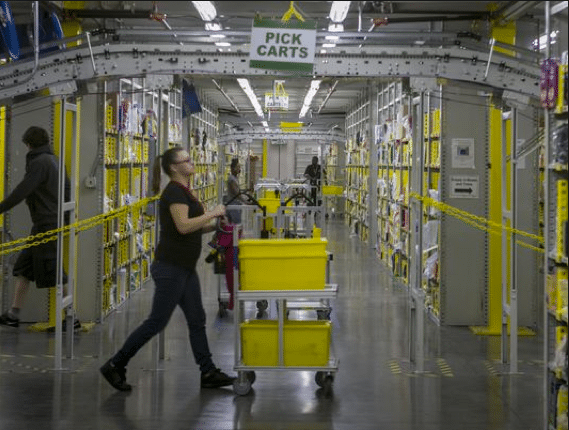Warning: Undefined array key 1 in /var/www/wp-content/plugins/monarch/monarch.php on line 4359
By Glenn Baja
It’s over. Finished. Complete.
So what’s it like to work at Amazon during the Christmas season, their busiest time of the year?
To put it plain and simple, you work your ass off.
The life-sucking work is hard and the hours are long. It’s boring, repetitious, monotonous, and taxing on the body. It’s dark when you go to work and dark when you get home. By the end of the day you’re totally exhausted, feeling it in every cell of your body. All you can think about is sitting down and getting off your feet.
The best thing about the job was that it was temporary. Seventy-five days in this case. I didn’t need to deal with or tolerate the daily politics or grind of working at a job that’s so taxing on the body, mentally unfulfilling, and all-consuming of valuable time.
Working at Amazon is your typical all-American unskilled laborers job. You don’t have to be a rocket scientist to work here or have above normal smarts. This said, for some reason you still must show proof of high school graduation in order to work. Additionally, you’re asked upfront to apply only if you can be on your feet for at least 10 hours a day. Everybody says yes because they want/need/desire the job or opportunity.
Most have never done it.
After fixing dinner or grabbing a meal on the way home because you’re too darn tired to cook, it’s time to think about going to bed and starting the process over again. If you’re lucky and in somewhat decent shape, your body recovers enough to do it again. If not, you’re in for a very long day.
Recruitment
My Amazon experience started on October 7. I applied because I had heard horror stories and gripes of so many others who had worked there in the past and wanted to find out first-hand on my own. I was warned by friends that I was in for a rude awakening. Some tried to talk me out of going.
I didn’t listen. Some things you just need to find out on your own.
I applied to Amazon, along with my gal, in early March. Our plans were to travel to Campbellsville, Kentucky in my small 22-foot RV camper and spend the next few months indulged in the Amazon world. I was curious to work for a multi-billion dollar company, one very guarded from traditional media and somewhat shrouded in secrecy and controversy.
Besides, I love challenges and trying new things I’ve never done.
I was part of what Amazon calls their Camperforce workers. These are individuals who for the most part are retired and spend their days traveling the country in their RV’s living their dreams and doing whatever they wish. Many pick up seasonal jobs whenever and wherever they choose before moving on to the next one.
With a lifetime of work experience and wisdom behind them, not to mention great work ethics, dependability, and common sense, these RV’ers make the perfect type of seasonal employees Amazon seeks. After years of experience working with these people, Amazon views these mature and intelligent individuals as highly coveted and prized.
We were told by more than one manager that enrolling one Camperforce worker equates to 2-3 workers found by other means.
Recruitment of Camperforce workers by Amazon begins early each year, months in advance of the upcoming Christmas season. Some started working as early as August. All of us agreed to commit ourselves through December 23rd.
Moving Or Stationary
Most the jobs at Amazon equates to either being a stationary job or one that involves lots of movement. The receive department, for the majority of workers, involves planting yourself at one of the dozens stationary workstations located on each side of the many conveyers and grabbing boxed products off the line. The cases get scanned first and then the items inside get removed and scanned individually, counted, and placed on carts. The carts, once full, get scanned and passed on to the “stowers”, those people whose job it is to find space in the warehouse cubicles and drawers to store items until orders are placed later to buy.
As you might imagine, stowers move a lot. Finding locations with available storage space can be quite challenging especially during this time of year. It’s not until customer orders are placed that “pickers” roam the storage facilities gathering items together in totes that in turn get sent to the stationary packers. It’s not uncommon for pickers to register 12-14 miles or more per day gathering merchandise.
Packers then receive these totes on conveyers, scanning the totes first and then each item inside. The packers job is to pack each item in the most appropriate box or bag (the computer gives a recommendation), place a scanned label on the shipping medium, and send it down another conveyer where items get shipping labels and sent off.
One of the pluses of working the season at Amazon is losing weight, one that’s well documented by many seasonal workers. Some lose up to 30 pounds in these few months. Besides weight loss, there’s also some financial benefits. The job pays between $10-$11 per hour with a shift premium added for working midnights and/or weekends. When the 10 hour mandatory overtime day kicks in (for us it was the 3rd week in October) the 1.5 overtime rate does too.
Amazon also flips the bill for campground fees and utilities (propane excluded) for your entire stay. As an incentive to keep you until the end of the season, a $1 per hour bonus for every hour worked is paid at the end of the season.
Starting Day
Amazon starts new hires slowly. They realize 10-plus hours on your feet a day is not easy. The first day is a long drawn-out 7-hour introduction to Amazon and it’s fulfillment center. It focuses on common sense issues such as safety guidelines, restroom hygiene, learning the correct place where warehouse items live, and warehouse no-no’s that can get you reprimanded.
We learned where we could walk, what time breaks occur, and the location of time clocks. Amusing videos of sexual harassment skits were shown (be careful when giving out compliments!). Workers were also asked to lock restroom doors behind them when entering (stamp-out promiscuity!). Once I was reprimanded for holding hands with my consenting partner on the walk to the lunchroom.
Some people just don’t have anything better to gripe about!
Security at the Campbellsville, Kentucky plant is strict and taken very seriously. Every time you leave the warehouse and/or enter the lunchroom you must go through a metal detector. It doesn’t matter whether it’s a 15 minute break, lunchtime, or the end of your shift. If one looks carefully around the warehouse cameras can be spotted mounted from the ceiling and walls throughout. They can be zoomed-in very close and with great detail. Every month a list is posted for employees describing the past month’s arrest in detail, how they were caught, and the results of the infraction.
One fellow was busted for putting a camera lens cap between the crack of his ass and walking out. Imagine losing your job over a $1.29 item.
Obviously, he wasn’t using his brains!
Virtually all infractions end in termination and often prosecution.
Changes & Challenges
The first 2 weeks of work is an “adjustment” period. This means shorter days and work weeks (no overtime day) with start times at 6 am and finishing at 11. This period is used to build up your endurance, stamina and adjusting to being on your legs for long periods of time. All new hires are required to start this way.
Once beyond the adjustment period, and after overtime kicks in, workdays would start at 4 am and conclude about 7:30 pm. Actual start and finish times were 6:30 am and 6 pm., but with travel time, meals, working-out, and bathroom duties the days were much longer.
Amazon had it’s challenges. As Christmas time inched nearer the Campbellsville plant received an SOS call from the Jeffersonville, Indiana Amazon plant located 20 minutes north of the Ohio River near Louisville, KY. Their workers had been on mandatory overtime since early September and still couldn’t keep up with the workload.
The Jefferson plant is a 1.7 million square foot mega-sized building that’s been in operation for just over 3 years. It’s specialty is apparel and it’s the fastest growing segment of all Amazon. Seventy-percent of all apparel that Amazon ships to North America comes out of this location.
They needed help.
Desperately.
Competition for help is fierce in this area. The industrial park that this Amazon warehouse is located in is just one of a dozen other mega-businesses found here. Finding good temporary help is difficult. To fill this need Amazon resorts to any means available to fill these shortages. Employment agencies are hired, job fulfillment companies are used, help-wanted billboards are placed along highways, ads are listed in the paper and various publications, and “finder fees” are offered to workers who bring in friends that last at least 2 weeks.
The needs are so great that Amazon will hire just about anyone at this time of year.
Unfortunately, this was quite obvious at the Jefferson plant. The work ethics and practices of many temps is far short of admirable. And I’m stating this in the kindest way possible.
To help solve their problem, an offer was made to all Camperforce workers: If you’d be willing to relocate to this plant and commit to helping out through the Christmas season each person would receive a $500.00 bonus, after taxes, at the end.
They were looking to sign-up about 100 people.
The hassle of relocating RV’s, leaving familiar grounds and friends, and moving northwards a couple of hours towards colder temperatures just didn’t have the appeal or impact they had hoped for. Only 35 people signed up. To this, Amazon countered with an offer of $1000.00 per person net, after taxes. Within a couple of days all 100 positions were filled. Amazon was paying over $100,000.00 to have 100 good dependable workers come and work for them for four weeks!
Everybody was to be on the same weekly shift, same pay, and be either a picker or a packer.
The New Job – Packing
My job at the plant was packing. I’d requested picking but was tricked into packing (I preferred putting in the miles to get a work-out). Instead of picking the packs, I’d been stuck with packing the picks (ignore the poor humor).
The little training we received sucked and was close to being non-existent. It was obvious why retaining help at this plant was a challenge. I shifted my attitude by asking “what’s great?” about this job. It took a few days but I soon prevailed!.
Packing is not a job that takes any special talent or know-how. It’s largely brainless. It can be performed by nearly anyone who can follow repeated computer directions time and time, and time and time again. You get the picture. If you can follow directions, and do it for 10-11 hours straight, you can be successful.
Like I said…boring, repetitious, and monotonous.
The most exciting aspect of packing is the thrill of choosing a box that’s a better fit than the one recommended by the computer.
Cheap thrills!
But packing, in all honesty, is serious business. This is the all-so-important first impression the customer has. Speed of packing was greatly emphasized, but quality, accuracy, and customer satisfaction was of first and foremost concern.
The packing area consists of 8 conveyer belt-lines each with 24 packing stations, 12 per side, per line. That made a total of 192 stations when operating at full potential. A packers job is to scan one tote at a time, scan each item in the tote, pack each item in bags or boxes, place a scanned label on each, and send it down another conveyer where it gets a shipping label and shipped out.
No background music is played and you’re not allowed to bring any of your own. All one can hear is the swirl and clanking of conveyer belts, the beeps and shuffling of scanners and totes, and the occasional obnoxious alarm that packers use to call for help when problems arise.
The numbers of items passing through this warehouse is astounding. A 24-hour record was set when 38,000 items were packed and shipped. A seasonal record was also shattered when 604,000 items were shipped compared to the old record of 497,000.
The Camperforce workers helped make this possible.
Lessons learned
Everyday, and in everything I do, I try to find and reflect on the growth opportunities that each experience brings. I’m not yet as good as I’d like to be at this, but I find it helps me to focus on the positive aspects of life.
The following are some of the lessons I learned from my experience at Amazon:
1. I know deep-within that If I exerted the same kind of time, energy, and focus that I put into Amazon into re-creating my own life, I could make anything happen. I often have a tendency to become lax and easily distracted. Experiencing and observing first-hand what it takes to run and operate a successful business day-in and day-out is an important reminder of the attention and energy one must exert to create success.
2. Repetition is key. The more you do something the better you become. I became a packing machine robot by the time I finished the job. Creating good work habits, repetitively, is a great goal to have and reach for.
3. I cannot create the kind of success I am looking for on my own. It takes a team. I need to let go of being a perfectionist and my need for control and begin extending myself out to others. Asking for help is not a sign of weakness.
4. We all are capable of doing anything for a short time period. It doesn’t matter how difficult or trying the circumstances may be. Knowing a task will soon end makes it bearable. We are much stronger than we sometimes give ourselves credit for.
5. The best part of this experience wass the people I met and life-long friendships that were created. This in itself holds enough “gold” to of made the entire experience worth it. My heart-felt thanks goes out to each and everyone of you!
I’ve been asked, “Would you do it again?” The best answer I can give is similar to asking a woman if she would have another baby after giving birth. The answer is always no.
But then again, we all know how many women have more than one child.
If I did, I’d know exactly what to expect both mentally and physically. Just having this knowledge would make the task more tolerable.
Sure, the job is tough, but so is delivering a baby.
Whiners need not apply…
Did you enjoy this post? Please share it with others!
[purehtml id=1]
I’m a self-professed madman, adventurer, photographer, certified High-Performance Coach, martial artist, and licensed physical trainer specializing in senior fitness. My passion is to continue growing and developing into my own unique, gifted, and joyful authenticity, while committing myself towards doing my own special part to help change the world. My mission is to help others find their own direction and purpose in life, by means of mentoring, teaching, and empowering.







